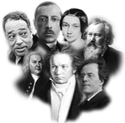
Coming to classical music from popular music is less of a leap than you might think. 
"Classical Music for Newcomers" by James Manheim in All Music Guide to Classical Music 
"Do you like classical music?" Some people answer, "Yes, but I don't know anything about music." Well, if you've encountered a piece of classical music that you loved, then you know more than you think you do. Classical music is everywhere around us - in movies, in television commercials, in schools, in the memories of our parents and grandparents. Anywhere that it's caught your attention is a good place to start. Whether you learn classical harmony or rock guitar, you'll study chords and how they fit together. Musicians don't tend to worry much about categories. Classical and popular music share many aspects of musical language. Yet there are some big differences as well. While coming from popular to classical music is less of a leap than you might think, there are a few ways in which you would need to retune your ears. One important difference is in regard to duration. Popular songs are usually short; mostly under five minutes. Classical compositions, on the other hand, range from 20-seconds to well over an hour, but the general average is between 15 and 45 minutes. Another difference is that popular music is mostly vocal music. Whatever the style, there is usually a singer and a text which carries the biggest part of the music's meaning. But vocal music is only a province of classical music. Even in the realms of opera and art song, the music itself is the message. Though classical music is very much a living tradition today, it also has a thousand-year history of being preserved for posterity through musical notation. Popular music, sometimes notated, most often includes spontaneous elements. Though it has a deep history of its own, our knowledge of music that was never written down is limited to a period beginning just over a century ago, when the first recordings were made. Whereas popular music, very broadly speaking, depends on interaction between performer and song, classical music rests on a triad: performer, composition, and composer. And generally speaking, the dynamic range, the difference in volume between the loudest and the softest moments, is greater in classical music than in pop. Some classical pieces are very loud, some are very soft, and some vary widely within a single piece, sometimes so extremely that before digital recording techniques, it was nearly impossible to capture the full range. It's no accident that the salesperson at a high-end stereo shop will bring out a classical CD to demonstrate what a fine pair of speakers can do. Too many people have the idea that classical works can be understood or enjoyed only by an elite group of lifetime concertgoers. But nothing could be further from the truth. There are plenty of ways to get a foothold. Just like any other music, classical music is full of tunes. A tune is often the piece's central "idea" - if you hear a melody that catches your ear, it's fun to hear how it's used over and over again with small or large variations. For example, many factors work to make the famous first movement of Beethoven's Fifth Symphony such a powerful piece of music, but the single most important one is the way the dramatic short-short-short-LONG motif heard at the beginning is worked and reworked and reworked again. One of the joys of classical music is its endlessly varied instrumental combinations - pieces are written for everything from one gentle instrument (Bach's Suite for Solo Cello No. 4) to Mahler's so-called "Symphony of a Thousand," which does indeed approach four figures in the orchestral and choral forces required. Some classical listeners prefer music written for small groups such as a string quartet - "chamber music," as it's called. And nearly everybody who has tried sitting down to a piano keyboard has had a brush with some of the classics for solo piano. And it may help you grasp the spirit of a classical piece to know where and when it was composed. Classical music represents a thousand years of the cultural history of Europe, America, and the rest of the world. As you become familiar with the rudients of music history, it is often easy to place an unknown work in time it came from. Most of the music we hear in recordings and concerts dates from between 1700 and the present day, but more and more performers are now exploring Medieval and Renaissance music. The relationship between the aural flavor of a piece of music and the historical culture that produced can be very evocative. The soaring spaces of a Gothic cathedral in Paris seem to come alive when you hear the vast four-part organum of Perotin the Great - as do the devotional spirit of German Lutheranism in the cantatas of J. S. Bach and the American preoccupation with landscape in Aaron Copland's Appalachian Spring. Why each person develops a particular attachment to certain pieces of music cannot be answered. No matter what the experts tell you, no matter how many courses on musical appreciation you take, no matter how "great" or important a piece is, if after listening to it several times its language still says nothing to you, then it simply may not match your taste. And indeed certain composers seem to match very few tastes except those of the irrelevent and self-sustaining world of academia. But above all, trust your feelings. Feeling the music, your visceral or emotional reaction, is far more important than understanding it. The greatest composer is the one whose music touches you most deeply. 
Home / Of General Interest / Words About Music |